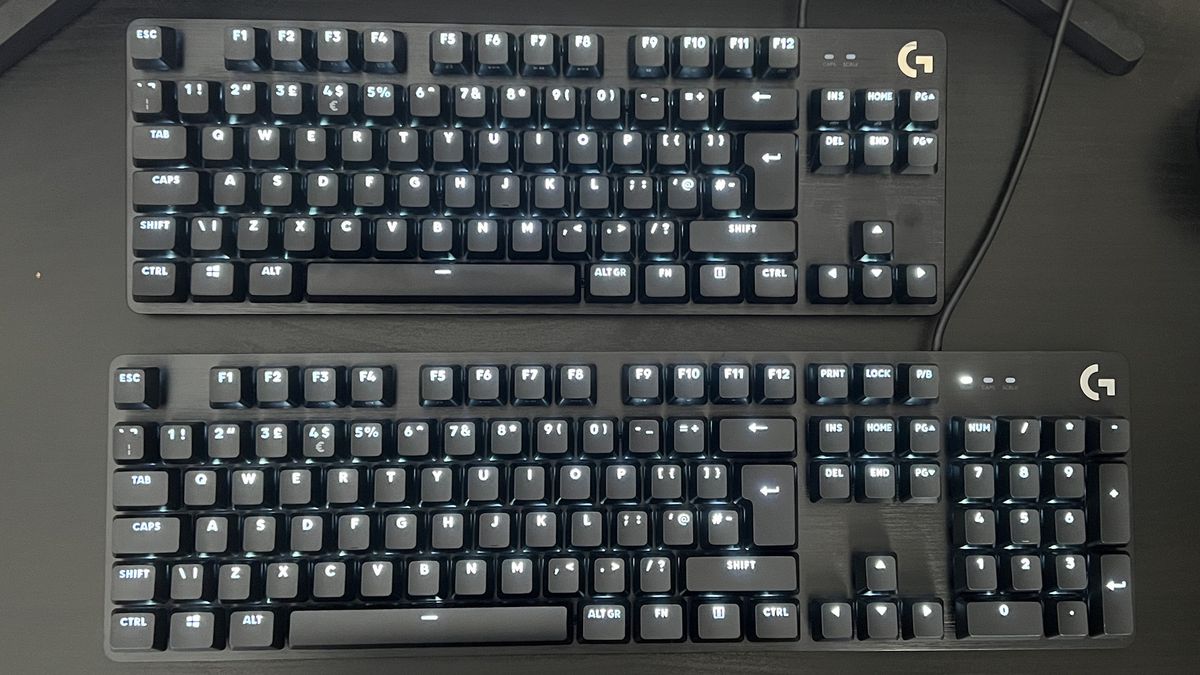12DOVE Verdict
The Logitech G413 SE is a cheap gaming keyboard designed to get the bare minimum of the job done for a fraction of a mechanical deck's usual price. However, these basic functions aren't enough to keep it competitive in today's market, even against its own predecessor.
Pros
- +
Subtle, slimline design
- +
Well constructed
- +
Cheaper than most other mechanical keyboards
- +
Available in TKL form factor
Cons
- -
Drops several key features
- -
Can't keep up with current prices on previous model
- -
Heavy, uncomfortable switches
Why you can trust 12DOVE
The Logitech G413 is well regarded as a solid budget option for anyone after a gaming keyboard that won't break the bank. 2022 brings us a new edition, available in both full-sized and TKL form factor, but the Logitech G413 SE model doesn't quite live up to the prowess of its forefather.
The full-sized model will set you back $79.99 / £69.99 - that's just $10 less than the original Carbon device, which is a little disappointing considering you're dropping a few key features and even more frustrating when you realize you can easily find the old model on sale for far less anyway. The TKL model does offer something more, with its streamlined form factor and lower $69.99 / £59.99 price point, though.
We tested both models with brown tactile switches to see where they stand among today's cheap gaming keyboards, and whether you're getting your money's worth out of these budget decks.
Design
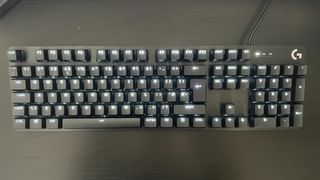
To offer credit where credit's due, this is a good-looking gaming keyboard. Both the full and TKL Logitech G413 SE offers a streamlined form factor with skinny bezels, a compact deck of keys, and a shorter height. Each keyboard comes in a full-black aesthetic, which contrasts the bright white LEDs under each key nicely. This is a simple design, but it was actually nicer to look at than some of the more garish keyboards on the market right now. There's no RGB fireworks in the corner of your eye, and no ostentatious dials, ports, or angular lines to contend with either. An ever-so-slightly brushed top plate is your lot here, with a shiny G logo adorning the top right-hand corner.

Average price: $79.99 (full) / $69.99 (TKL) | £69.99 (full) / £59.99 (TKL)
Type: Mechanical
Size: Full / TKL
Switches: Long Hua Tactile Brown
Keycaps: PBT
Media keys: None
Wrist rest: None
USB passthrough: None
Of course, this subtle design is achieved by ripping many key features out (more on that further down), but if you don't want your desk to look like an amusement park this is an excellent option.
The aluminum top plate holds up well and there's no flex or annoying switch reverb to be concerned about either. The whole deck feels solid - far more durable, in fact, than other models which can easily run you into three-figure pricing. I was surprised to find PBT keycaps under my fingertips here as well. They offer a textured surface and a particularly comfortable keycap feel rarely found at this lower price point.
Features
The spec sheet is where things start to go south. The Logitech G413 SE is a stripped-back product. Logitech wants to offer a simple set of mechanical switches at an affordable price point, which means you're dropping a heavy load of additional features - some of which have become stock standard on even budget gaming keyboards. There are no dedicated media keys, macro controls, RGB lighting, wrist rest, or key programming here, and the SE model is not compatible with Logitech's G-Hub software.
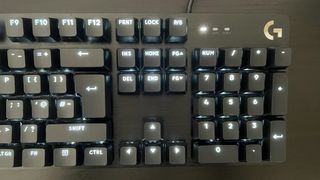
That would all be fine if Logitech was focusing on its key switches at this price point. Unfortunately, it's not. The G143 SE uses brown tactile Long Hua switches, a cheap Khailh-like with a particularly heavy feel. My fingers are tired just typing this review. While I did find them to be particularly smooth, and with very little reverberation around the insides of the case, these are loud, stiff switches that feel clunky under hand and cumbersome to actuate. Many gaming keyboards do offer budget switches at this price point, but when each keystroke is this unwieldy, it's well worth pitching your budget a little higher for a set of Cherrys at least - your knuckle joints will thank you later.
The Logitech G413 SE also drops the USB passthrough of the previous model and doesn't offer a Windows lock key (though I never had any issues accidentally heading out to my desktop in-game). You are, however, still getting six-key rollover and anti-ghosting - even if the previous model offered 26-key rollover.
Performance
The core experience of using the Logitech G413 SE is still fairly strong. Responses feel nippy and key spacing is comfortable for both typing and precision gameplay. Even if hammering those switches took more effort than it reasonably should, it was still a better gameplay experience than that offered by the even heavier membrane keys offered in the SteelSeries Apex 3 TKL. I still managed to just about maintain my standard typing speed here, though it was far less comfortable than usual.
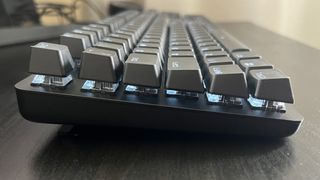
The lack of dedicated macro buttons or programmable keys means that more complex gameplay maneouvres did require a lot of twisting and contorting to pull off. That's only a problem because I'm used to my own setup for games like Apex Legends, though - if you don't remap your keys you certainly won't be missing much here. However, if you're coming from a fully programmable deck, expect to do some re-learning.
Still, I never had any problems with reporting and that slimline design also meant more space to swing a mouse as well.
Should you buy the Logitech G413 SE?
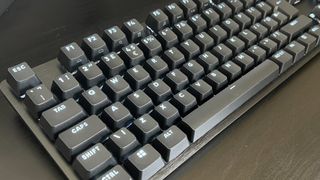
At its current price, it's hard to recommend the Logitech G413 SE. The full-sized version is simply out pipped by its predecessor in everything from features to switch feel, and these days its base price is actually more expensive than the G413 Carbon's regular sales cost. I'd heavily recommend anyone on the hunt for a budget mechanical keyboard skip past this entry and look further back through time for a richer experience and better value for money. There is one scenario where the G413 SE makes sense, though, and that's if you're looking to save even more space with a TKL form factor.
However, if you'd prefer a lighter switch, it's worth taking a look at the HyperX Alloy Elite 2 instead. While the $129.99 MSRP will set you back around $50 more, we actually see this model on sale for around $89.99 more often than not. That's around the same price as the G413 SE and you're getting smooth linear switches, media controls, and macro customizations.
For those going as cheap as possible, you'll find far more features in the Razer Cynosa V2 (for under $50 no less). You are moving away from mechanical switches here, but these membrane keys still feel great and they're a good deal quieter as well.
How we tested the Logitech G413 SE
I used both the full sized and TKL versions of the Logitech G413 SE over the course of one week, with the keyboard taking its place as my daily driver for all things work and play. I tested gameplay using Apex Legends, Cities Skylines, and Shadow of the Tomb Raider primarily, while also measuring performance against competitors like the HyperX Alloy Elite 2 as well as the previous Carbon model.
If you're really looking to spend some cash, we're also rounding up the best wireless gaming keyboards on the market. Or, for more flexibility in your switch, check out the best hot-swappable keyboards available now. You'll also find all the best gaming mouse options right here as well.

Managing Editor of Hardware at 12DOVE, I originally landed in hardware at our sister site TechRadar before moving over to GamesRadar. In between, I've written for Tom’s Guide, Wireframe, The Indie Game Website and That Video Game Blog, covering everything from the PS5 launch to the Apple Pencil. Now, i'm focused on Nintendo Switch, gaming laptops (and the keyboards, headsets and mice that come with them), PS5, and trying to find the perfect projector.

Game of Thrones author George R.R. Martin says "there is some talk about making a movie out of Elden Ring" but admits there's a big novel-sized block in his way

The League of Legends fighting game spin-off won't be getting its big playtest, but that's so that more of you can play it later this year

Updating my handheld is one of the best decisions I ever made, and now Best Buy has finally released this OLED Switch bundle so you can too
Most Popular




